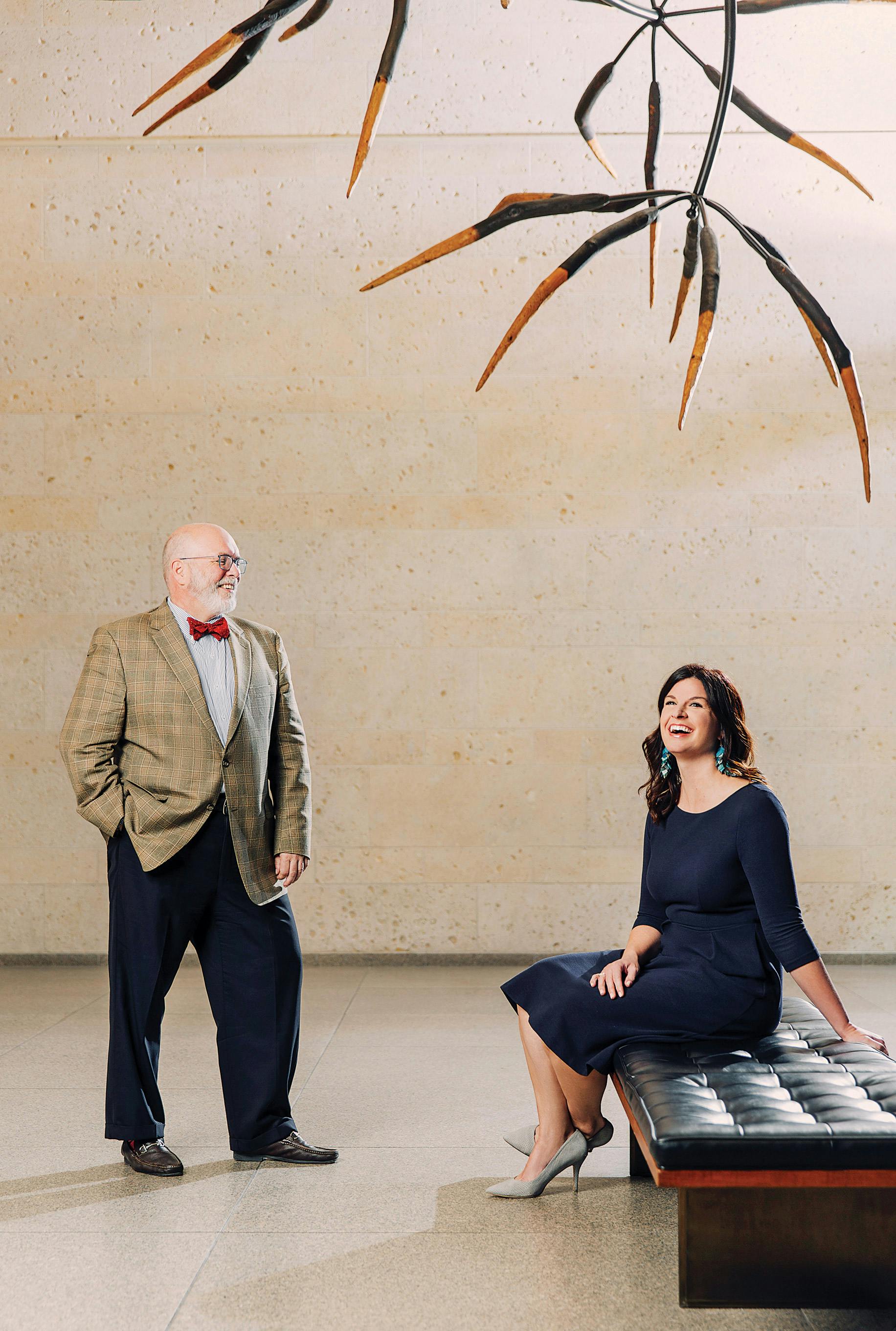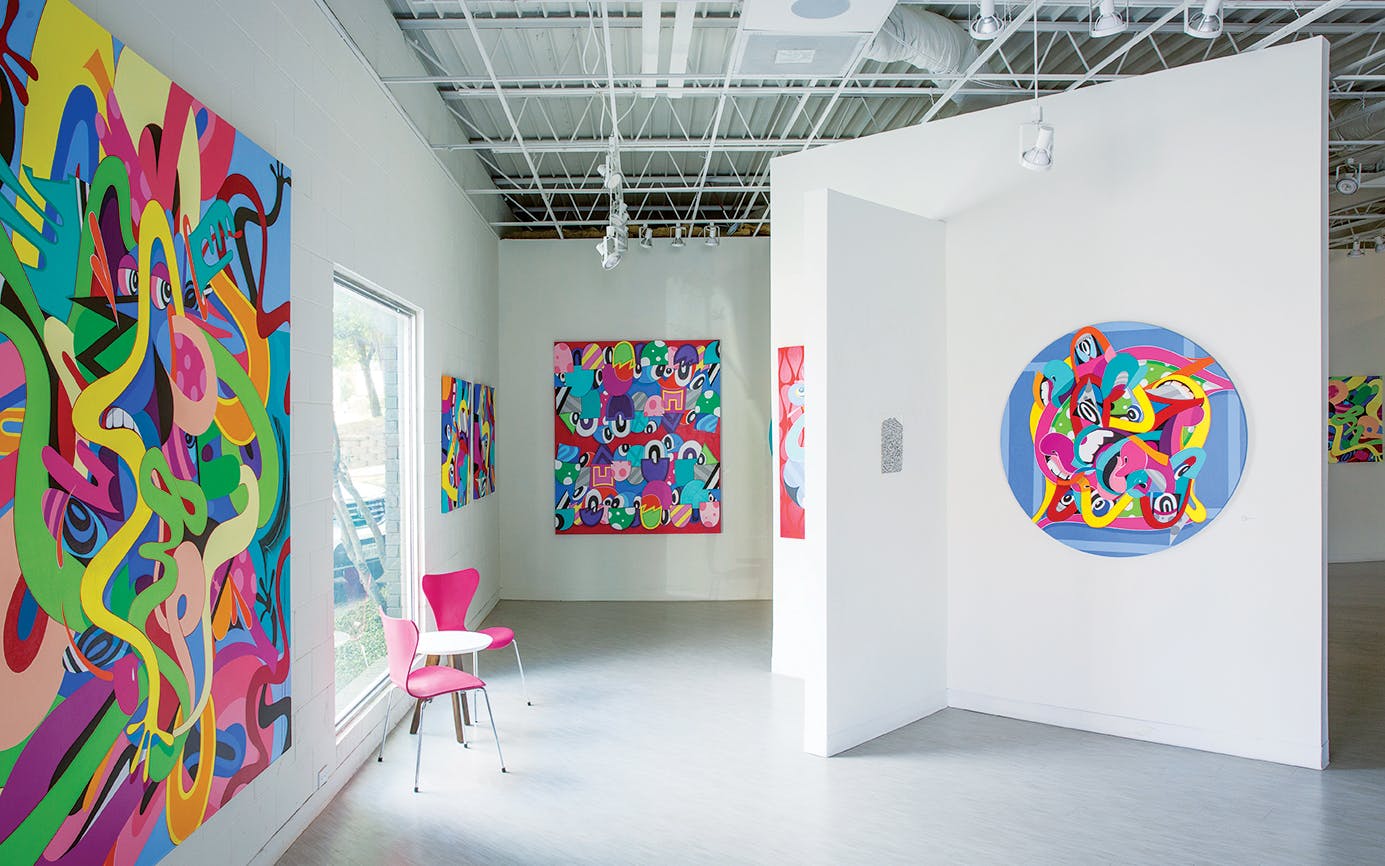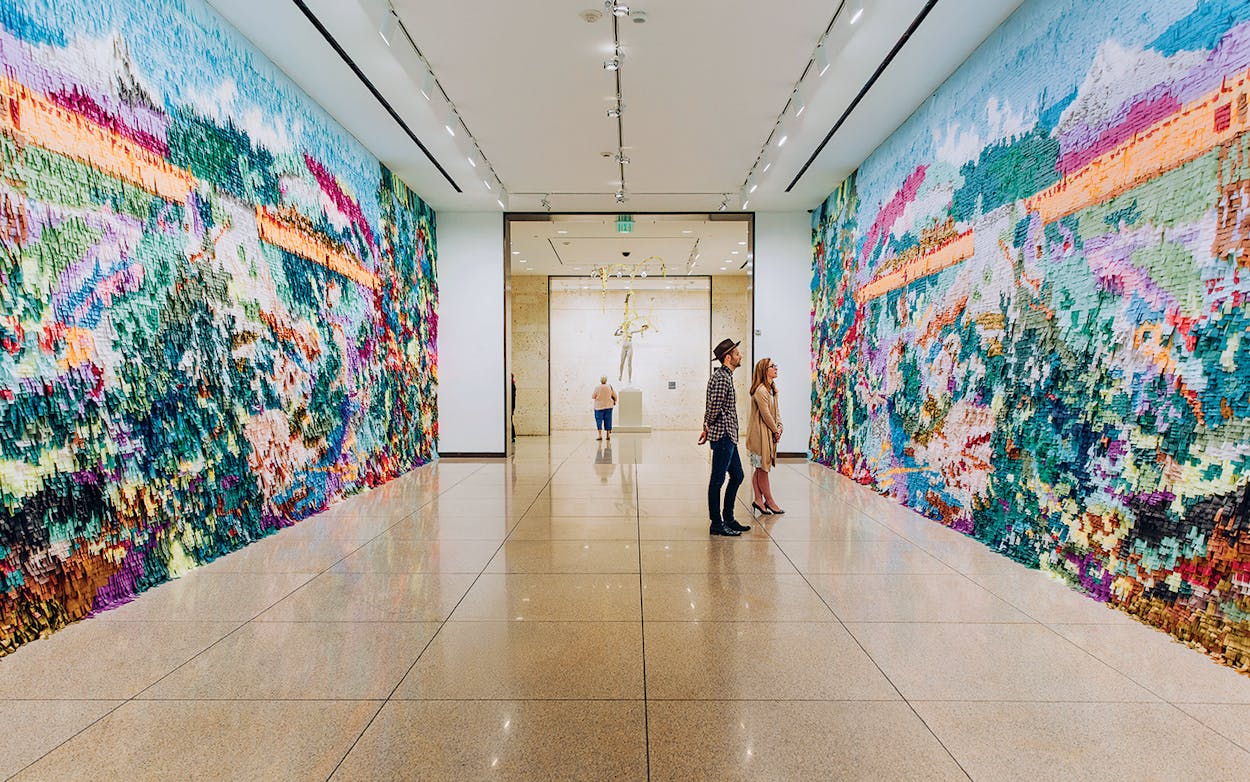When visitors walk inside the newly renovated Amon Carter Museum of American Art, the first thing they’ll now see is Seven and Seven Flower, Texas sculptor James Surls’s fifteen-foot-tall pine-and-steel cluster of blossoms, dangling from the ceiling. Sunlight enters the lobby through architect Philip Johnson’s mesmeric panel of windows, casting spidery shadows on the wall. A few feet away, Richmond Barthé’s bronze bust The Negro Looks Ahead has been reinstalled from elsewhere in the building to now gaze out at the Amon Carter’s immense porch.
After closing to undergo the final leg of a $9 million modernization over the summer, the museum reopened in September. The carpets and cramped galleries have been replaced with wooden floors and modular walls that curators can rearrange with ease. The upstairs spaces are brighter and more expansive too; new coffered ceilings are embedded with panels of LED lights not unlike the skylights that were a part of Johnson’s original plan for the 1961 building but were never installed.
It’s not just the structure and decor that have changed. The Amon Carter, best known for its collection of nineteenth- and early-twentieth-century American Western art, has also expanded its holdings. One notable addition: Justin Favela, a Las Vegas–based installation artist, has transformed a downstairs hallway into one long portal made of tissue paper and glue. He calls the piece Puente Nuevo (“New Bridge”); it nods to Mexican printer Casimiro Castro’s nineteenth-century color lithographs of railway bridges.
In addition to the remodel, curators are rethinking how to display the museum’s pieces, placing them in new contexts to promote a dialogue between the past and present (before, pieces were arranged chronologically). In a room of nineteenth-century landscapes, visitors can watch a 2010 video of the Grand Canyon by Texas artist David Politzer. In the same room, the Hudson River School painter Worthington Whittredge’s 1876 work On the Cache La Poudre River, Colorado is juxtaposed with photographer William Wylie’s 1996 print depicting the same river. The Amon Carter now also boasts more room for larger-scale touring exhibitions like “Gordon Parks: The New Tide, Early Work 1940–1950,” which runs until December 29 and features the African American photographer’s documentation of midcentury black American life.
This transformation of one stalwart Fort Worth institution isn’t a solitary shift; it’s just the latest high-profile change in a surging local art scene. The Amon Carter, along with the city’s other major art institutions, the Modern Art Museum and the Kimbell Art Museum, are engaging with the community in ways that may finally help the city’s homegrown artists flourish like their peers in Houston and Dallas, Fort Worth’s eternal rival.
For decades, local artists have felt that the Big Three museums were disconnected from the city’s art scene (though the Amon Carter and the Modern do have some pieces by Fort Worth artists in their permanent collections). For a city to have three world-class museums is an extraordinary boon, but residents have long observed that the city’s donor class hasn’t funded the sort of gallery scene that nurtures artists in the community.
That seems to be changing, and it’s part of a broader cultural and political evolution. Though Fort Worth has long been the state’s most conservative major city, Beto O’Rourke narrowly outpolled Ted Cruz in Tarrant County last year. Local artists say that a more progressive population is breaking with the status quo of Cowtown, and artists who once might have left for New York are staying put. Through the nimble use of social media, they are forming collectives, organizing pop-up galleries, and supporting each other. “Fort Worth is in an interesting position right now,” says Ariel Davis, an artist and organizer with the Art Tooth collective, a group of more than a hundred artists who stage exhibitions and workshops.“The city is growing, the mindset and politics are becoming more progressive, and small businesses are thriving and eager to partner with local creatives to shape the best Fort Worth that they can.”
The Big Three have also joined forces with artist cooperatives and nonprofits to link people in new ways. The Amon Carter, for instance, has established a productive relationship with local painter and UT-Arlington art professor Sedrick Huckaby by showing and purchasing his work.


One afternoon this summer, Huckaby, a Guggenheim fellow famous for portraits done in impasto, a technique that involves thickly layering on paint, was standing inside his studio and collaborative space Big Momma’s House. The bungalow, in Fort Worth’s Polytechnic Heights neighborhood, is named for his grandmother, who used to live there. The wood walls of one room are covered in faces he transformed from pencil drawings into lithographs—some of them frowning, others seemingly content—that Huckaby drew for his 2012 collection “The 99% – Highland Hills.” To conceptualize it, he approached people in the predominantly black Fort Worth neighborhood where he grew up and asked if he could sketch their portraits.
As he drew, they talked. “What I found out was, if you want answers to social problems in communities, the first thing you got to do is listen,” he says, his coveralls layered so heavily with paint that he resembles an oil painting himself. One man, for instance, told Huckaby he wanted to create a coloring book featuring significant figures from the community throughout history. “That’s a great idea,” Huckaby says. “And there are many people around here who either see answers to issues or have a great idea but just don’t feel empowered to do it. We need to hear from them.”
Andrew Walker, 55, the Amon Carter’s executive director since 2011, has been a catalytic figure in the museum’s outreach. Walker is at once cerebral and cheeky—he can casually riff on the Amon Carter’s modern contextualization of works like Thomas Cole’s 1845 painting The Hunter’s Return and then polish off a pint and regale you with amusing tales of a trip to New Orleans gone wrong. And that eclectic attitude plays out in his mission to amplify the voices of local artists. “Artists bring a lot of intuitive problem-solving,” Walker says. “We see artists not just as producers of things but as participants in the community. How can we build a model around that? We have a plan for a long-term nurturing of the community here.”
The Carter Community Artists initiative, launched in 2018 by Amanda Blake, the museum’s director of education, library, and visitor services, is a potent example of how the Amon Carter is bringing new points of view to its gallery walls. Last year, the museum hired four local artists—Christopher Blay, Lauren Cross, Diane Durant, and Arnoldo Hurtado—as consultants. The artists teamed up with the museum to hold events for communities around town throughout the 2018–2019 year. “Carter Community Artists bring their perspectives to our programs. They even lend their voices to our school tours,” says Blake. “We are asking, ‘How do we talk to kids from diverse backgrounds and help them to make meaningful connections with artwork created by or depicting people who don’t look like them?’ ”

Cross is also the founder of WoCA Projects, a nonprofit organization for female artists of color. One of the high points of her role as a consultant involved facilitating an ongoing relationship between the Amon Carter and east Fort Worth’s the Dock Bookshop, one of the largest African American–owned bookstores in the country. At the Dock, the storied black photographer Gordon Parks is a familiar name, but Cross says many of the store patrons she spoke with weren’t aware of the Amon Carter’s Parks exhibit. She decided to do something about that. In early August, the Dock and the Amon Carter cohosted a satellite event at the bookstore to celebrate Parks’s work. Blake spoke about his photography; a Malian drumming band played; and kids made self-portraits from photo booth images they took of themselves, accessorized in midcentury garb. “We have spoken-word artists, African drummers, and storytelling at the Dock all the time,” Cross says, “but to connect these artists to the museum with an event was exciting.”
Over the past few years, both the Modern and the Kimbell have also begun to collaborate with the local art scene. The Modern partners with Art Tooth to cohost parties and interactive events, and it funds the Teen / Artist Project, which selects several Fort Worth–area high school students to participate in a rigorous year of training with accomplished regional and national artists. The Nuestro Kimbell program, established in 2016, works with Latino civic leaders to help with outreach and organizing a bilingual speaker series; that year the Kimbell was also the first in Fort Worth to translate its permanent collection materials into Spanish.
The city’s government has likewise gotten into the act. The city’s Arts Council operates the Fort Worth Community Arts Center, located in the heart of the Cultural District, and has morphed in recent years from a place where children and retirees might try their hand at painting watercolor bluebonnets to a space where notable local artists show their work. Two years ago, the center launched a yearlong artist residency for local art collectives.
This isn’t just a top-down movement, though; grassroots efforts are also coalescing. Artist Lauren Childs operates a contemporary gallery in the Cultural District called Fort Works Art as well as a separate nonprofit space, Gallery of Dreams. It hosts an artist residency and a high school art competition, curated and judged by the likes of Walker and Andrea Karnes, the Modern’s senior curator, as well as prominent local artists such as Huckaby and Benito Huerta. “Imagine having someone from the Carter or the Modern curate your art when you were in high school,” says Childs. “I wanted these kids to feel like rock stars for a day.”

Childs didn’t intend to become a gallerist; she just wanted a place to show her own art. In 2014, Eddie Vanston, an investor and the proprietor of the nightclub Shipping & Receiving, told Childs she could use the bar’s warehouse free of charge if she agreed to clean it up. She hosted pop-up art shows there for two years before moving Fort Works Art into its current space, which is more than five thousand square feet, in 2016. The gallery has become one of Fort Worth’s top promoters of local art.
“I’ve recently seen our city come alive,” says Childs, who has been a resident for more than forty years. “Fort Worth has always been culturally significant because of the major museums, but now local artists are becoming their own advocates. There’s a major shift happening now.”
In the summer of 2019, in a studio adjacent to Fort Works Art’s main gallery, Marshall Harris leaned over a drawing table, sketching with pencils. A former football star at Texas Christian University, Harris, 63, is now dedicated to creating art, most notably graphite drawings that are so realistic they resemble high-res photographs. A Styrofoam head he’s topped with a crown of pecan branches—the subject of a future drawing—is perched on the table. A wall is covered with his “baggie art,” a grid of dangling plastic ziplocks containing personal mementos. “If you’re an artist, you need room, you need equipment, you need to make a mess,” Harris says. “Most artists can’t pay two rents. Residency programs like this are the incubators for creativity that allow artists to stay in Fort Worth.”
Open studios also fuel the relationship between artists and the public. When Harris had his residency in the gallery (it’s since ended), he and visitors could talk face-to-face, which led to interesting interactions and commissions. “What’s happening here is the whole purpose of art,” says Harris. “I don’t want to make art just to look at. I want to capture a moment and an emotion and try to communicate that to someone who might be moved to ask a question, even something so simple as ‘What kind of pencils do you use?’ ”
Despite the success of Fort Works Art and other artist-focused spaces, like Artspace111, Fort Worth still has relatively few galleries for a city of its size. “It’s because of this vacuum that artists started working together,” says Art Tooth’s Ariel Davis. That’s led to a surge in art collectives in town, including Art Tooth, Art Room, and Latino Hustle, all of which have sprung up over the past five years.
On a Friday night in July, I stopped by a group show at Fort Worth Community Arts Center. Artists from various collectives showed up; project brainstorming happened around the tables on the FWCAC’s porch. Harris was there talking with Jonathan Levy, the building’s director, about ways to use the old bomb shelter in the basement. The San Antonio–based artist Dongyi Wu, whose work was a part of the group show, beamed while showing off her purselike body jewelry, which is inspired by lucid dreams. Another artist, Caroline Hatfield, stood amidst her large installation of crushed recycled-concrete soil piles that form an archipelago on the floor of an otherwise bare white room. “Not every gallery is going to let you come in and throw dirt all over the floor,” she says, giving voice to enthusiasm for the sort of artistic license that’s become more possible in town.
This article originally appeared in the December 2019 issue of Texas Monthly with the headline “Fort Worth Art Steps Into the Future.” Subscribe today.
- More About:
- Art
- Fort Worth







